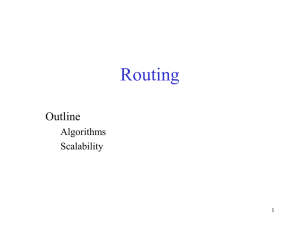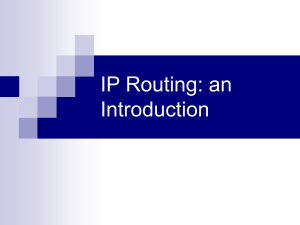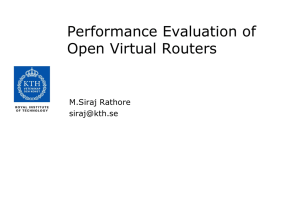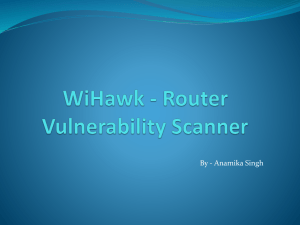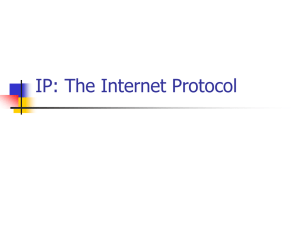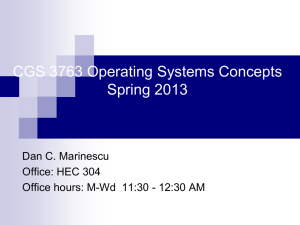Chapter 06 - Reading Organizer
advertisement
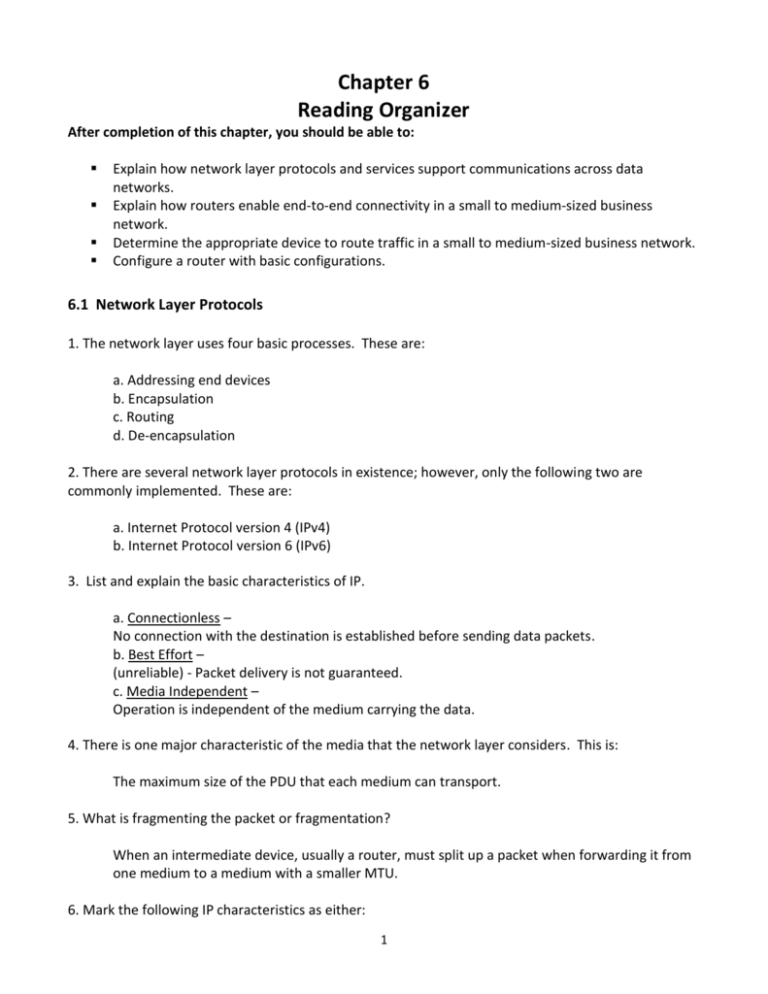
Chapter 6 Reading Organizer After completion of this chapter, you should be able to: Explain how network layer protocols and services support communications across data networks. Explain how routers enable end-to-end connectivity in a small to medium-sized business network. Determine the appropriate device to route traffic in a small to medium-sized business network. Configure a router with basic configurations. 6.1 Network Layer Protocols 1. The network layer uses four basic processes. These are: a. Addressing end devices b. Encapsulation c. Routing d. De-encapsulation 2. There are several network layer protocols in existence; however, only the following two are commonly implemented. These are: a. Internet Protocol version 4 (IPv4) b. Internet Protocol version 6 (IPv6) 3. List and explain the basic characteristics of IP. a. Connectionless – No connection with the destination is established before sending data packets. b. Best Effort – (unreliable) - Packet delivery is not guaranteed. c. Media Independent – Operation is independent of the medium carrying the data. 4. There is one major characteristic of the media that the network layer considers. This is: The maximum size of the PDU that each medium can transport. 5. What is fragmenting the packet or fragmentation? When an intermediate device, usually a router, must split up a packet when forwarding it from one medium to a medium with a smaller MTU. 6. Mark the following IP characteristics as either: 1 a. Connectionless b. Best Effort c. Media Independent. _____A____ Will send a packet even if the destination host is not able to receive it. _____B____ Does not guarantee that the packet will be delivered fully without errors. _____C____ Will adjust the size of the packet sent depending on what type of network access will be used. _____B____ Packet delivery is not guaranteed. _____C____ Fiber optics cabling, satellites, and wireless can all be used to route the same packet. _____A____ No contact is made with the destination host before sending a packet. 7. An IPv4 packet has two parts. These are: a. IP Header b. Payload 8. The fields used to identify and validate a packet, or reorder a fragmented packet include: a. Internet Header Length (IHL) b. Total Length c. Header Checksum 9. Why would a router have to fragment a packet? When forwarding it from one medium to another medium that has a smaller MTU. 10. Draw a line between the IPv4 header function and the correct category. Version Identifies the IP address of the recipient host Total Length Identifies the number of 32-bit words in the header Time-to-Live Always set to 0100 for IPv4 Protocol Internet Header Length Identifies the IP address of the sending host Identifies the upper-layer protocol; to be used next 2 Destination IP Address Maximum value is 65,535 bytes Differentiated Services Commonly referred to as hop count Header Checksum Identifies the priority for each packet Source IP Address Error-checks the IP header – if correct, the packet is discarded 11. List and explain the three major issues IPv4 has. a. IP address depletion – IPv4 has a limited number of unique public IP addresses available. Although there are approximately 4 billion IPv4 addresses, the increasing number of new IP-enabled devices, always-on connections, and the potential growth of less-developed regions have increased the need for more addresses. b. Internet routing table expansion – A routing table is used by routers to make best path determinations. As the number of servers (nodes) connected to the Internet increases, so too does the number of network routes. These IPv4 routes consume a great deal of memory and processor resources on Internet routers. c. Lack of end-to-end connectivity – Network Address Translation (NAT) is a technology commonly implemented within IPv4 networks. NAT provides a way for multiple devices to share a single public IP address. However, because the public IP address is shared, the IP address of an internal network host is hidden. This can be problematic for technologies that require end-to-end connectivity. 12. List four improvements that IPv6 provides. a. Increased address space b. Improved packet c. Eliminates the need for d. Integrated security 13. How many addresses does IPv6 provide? 340,282,366,920,938,463,463,374,607,431,768,211,456 14. The IPv6 simplified header offers several advantages over IPv4. These include: 3 a. Better routing efficiency for performance and forwarding-rate scalability b. No requirement for processing checksums c. Simplified and more efficient extension header mechanisms d. A Flow Label field for per-flow processing with no need to open the transport inner packet to identify the various traffic flows 15. The fields in the IPv6 header include: a. Version b. Traffic Class c. Flow Label d. Payload Length e. Next Header f. Hop Limit g. Source Address h. Destination Address 16. Draw a line between the IPV6 header description and the IPV6 header field to which it belongs. Traffic Class Hop Limit Next Header Version Flow Label Payload Length Is always set to 0110 Identifies the packet fragment size When this value reaches 0, the sender is notified that the packet was not delivered Classifies packets for congestion control Identifies the application type to the upper-layer protocol Can be set to use the same pathway flow so that packets are not reordered upon delivery 6.2 Routing 17. Another role of the network layer is to direct packets between hosts. A host can send a packet to: a. Itself b. Local host c. Remote host 18. The router connected to the local network segment is referred to as the ____default gateway____. 19. What is the purpose of a default gateway? To route traffic from the local network to devices on remote networks. 4 20. Explain what a routing table is. A routing table is a data file in RAM that is used to store route information about directly connected network, as well as entries of remote networks the device has learned about. 21. The routing table of a local host typically contains what information? a. Direct connection b. Local network route c. Local default route 22. The default gateway is only used when a host must forward packets to a remote network. When is a default gateway not required, or needed to be configured? If you are only sending packets to devices on the local network. 23. What commands on a Windows host can be used to display the host routing table? a. route print b. netstat -r 24. Identify the five different destination address sections shown in the netstat –r output. ___The local default route___ ____Loopback addresses___ _______Local network______ ____Multicast addresses____ _____Limited broadcast_____ 5 25. List and explain what the routing table of a router stores information about. a. Directly-connected routes – These routes come from the active router interfaces. Routers add a directly connected route when an interface is configured with an IP address and is activated. Each of the router's interfaces is connected to a different network segment. Routers maintain information about the network segments that they are connected to within the routing table. b. Remote routes – These routes come from remote networks connected to other routers. Routes to these networks can either be manually configured on the local router by the network administrator or dynamically configured by enabling the local router to exchange routing information with other routers using dynamic routing protocols. 26. What does a local host require to send packets to a remote destination? A default gateway 27. What command is used on a Cisco IOS router to display the routing table information? show ip route 28. What does each circled part of the routing table below tell the network administrator? _____How the route was learned_____ ___Identifies the interface through which the routes reaches the destination network__ C L C 192.168.10.0/24 is directly connected, GigabitEthernet0/0 192.168.10.1/32 is directly connected, GigabitEthernet0/0 220.200.20.0/24 is directly connected, GigabitEthernet0/1 _____The destination network and how it was learned_____ 6 29. Explain what the following letters in the routing table represent? a. ____C____ Identifies a directly connected network. Directly connected networks are automatically created when an interface is configured with an IP address and activated. b. ____L____ Identifies that this is a link local route. Link local routes are automatically created when an interface is configured with an IP address and activated. c. ____S____ Identifies that the route was manually created by an administrator to reach a specific network. This is known as a static route. d. ____D____ Identifies that the route was learned dynamically from another router using the Enhanced Interior Gateway Routing Protocol (EIGRP). e. ____O____ Identifies that the route was learned dynamically from another router using the Open Shortest Path First (OSPF) routing protocol. 30. Based on the routing table entry shown what is the…. D 200.20.2.0/24 [90/2170112] via 10.250.1.1, a. Route Source (which protocol)– EIGRP b. Destination Network – 200.20.2.0/24 c. Administrative Distance – 90 d. Metric – 2170112 e. Next-hop – 10.250.1.1 f. Route timestamp – 00:15:35 7 00:15:35, Serial0/0/1 g. Outgoing interface – Serial0/0/1 31. Which metric has the highest priority; 2170112 or 1? 1 32. If a router receives a packet to a destination network that is not in the routing table and no default gateway is available, what happens to the packet? The packet is dropped 33. Based on the graphic assign the correct letter to each statement. _____B____ Shows the destination network. _____C____ The administrative distance (source) and metric to reach the remote network. _____A____ How the network was learned by the router. _____F_____ The outgoing interface on the router to reach the destination network. _____E____ The elapsed time since the network was discovered. 8 _____D____The next hop IP address to reach the remote network. 6.3 Routers 34. All router models are essentially computers. Just like computers, tablets, and smart devices, routers also require: a. Operating systems (OS) b. Central processing units (CPU) c. Random-access memory (RAM) d. Read-only memory (ROM) 35. A router also has special memory that includes: Flash and nonvolatile random-access memory (NVRAM) 36. A router has access to four types of memory. Explain each. a. RAM – RAM is used to store various applications and processes including: Cisco IOS - The IOS is copied into RAM during bootup. Running configuration file - This is the configuration file that stores the configuration commands that the router IOS is currently using. It is also known as the running-config. IP routing table - This file stores information about directly-connected and remote networks. It is used to determine the best path to use to forward packets. ARP cache - This cache contains the IPv4 address to MAC address mappings, similar to the Address Resolution Protocol (ARP) cache on a PC. The ARP cache is used on routers that have LAN interfaces, such as Ethernet interfaces. Packet buffer - Packets are temporarily stored in a buffer when received on an interface or before they exit an interface. Like computers, Cisco routers actually use dynamic random-access memory (DRAM). DRAM – It stores the instructions and data needed to be executed by the CPU. b. ROM – Cisco routers use ROM to store: Bootup instructions - Provides the startup instructions. 9 Basic diagnostic software - Performs the power-on self-test (POST) of all components. Limited IOS - Provides a limited backup version of the OS, in case the router cannot load the full featured IOS. c. NVRAM – Is used by the Cisco IOS as permanent storage for the startup configuration file (startup-config). d. Flash memory – Is non-volatile computer memory used as permanent storage for the IOS and other system related files. 37. Identify the internal components of this 1841 router. ___Power Supply___ ___Nonvolatile RAM (NVRAM)___ ___Shield for WAN Interface Card___ 10 ___Shield for WAN Interface Card___ ___CPU___ ___Fan ___ ___Synchronous Dynamic RAM (SDRAM)___ ___Advanced Integrated Module (AIM)___ 38. Identify the ports on this 1941 ISR. 11 39. The connections on a Cisco router can be grouped into two categories. List and explain each. a. Management ports – These are the console and auxiliary ports used to configure, manage, and troubleshoot the router. Unlike LAN and WAN interfaces, management ports are not used for packet forwarding. b. Inband Router interfaces – These are the LAN and WAN interfaces configured with IP addressing to carry user traffic. Ethernet interfaces are the most common LAN connections, while common WAN connections include serial and DSL interfaces. 40. Similar to a Cisco switch, there are several ways to access the CLI environment on a Cisco router. List and explain the most common methods. a. Console – 12 Uses a low speed serial or USB connection to provide direct connect, out-of-band management access to a Cisco device. b. Telnet or SSH – Two methods for remotely accessing a CLI session across an active network interface. c. AUX port – Used for remote management of the router using a dial-up telephone line and modem. 41. Router interfaces can be grouped into two categories. List and explain both. a. Ethernet LAN interfaces – Used for connecting cables that terminate with LAN devices, such as computers and switches. This interface can also be used to connect routers to each other. Several conventions for naming Ethernet interfaces are popular: the older Ethernet, FastEthernet, and Gigabit Ethernet. The name used depends on the device type and model. b. Serial WAN interfaces – Used for connecting routers to external networks, usually over a larger geographical distance. Similar to LAN interfaces, each serial WAN interface has its own IP address and subnet mask, which identifies it as a member of a specific network. 42. Draw a line between the router component name and the correct function/description. WAN interface A way to remotely access the CLI across a network interface. Aux port Connects computers, switches, and routers for internal networking. LAN interface A port to manage routers – using telephone lines and modems. Telnet or SSH Connects routers to external networks, usually over a large distance. Console port A local port which uses USB or low-speed, serial connections to manage network devices. 43. Where is the Cisco IOS stored? Flash Memory 44. During boot up the Cisco IOS is copied into? RAM 45. Which two files are loaded when a router is booted? 13 a. IOS Image File b. Startup Configuration File 46. There are three major phases to the bootup process. These are: a. Perform the POST and load the bootstrap program. b. Locate and load the Cisco IOS software. c. Locate and load the startup configuration file or enter setup mode. 47. What command can be used to verify and troubleshoot some of the basic hardware and software components of the router? show version 48. The output from the show version command includes: a. IOS version b. ROM Bootstrap Program c. Location of IOS d. CPU and Amount of RAM e. Interfaces f. Amount of NVRAM and Flash 49. The configuration register has several uses, such as: Password recovery 50. The factory default setting for the configuration register is 0x2102. What does this value mean? This value indicates that the router attempts to load a Cisco IOS software image from flash memory and load the startup configuration file from NVRAM. 51. List the four steps to the router boot process in correct order. a. Preform POST b. Load Bootstrap c. Load the IOS d. Load the configuration file from flash 6.4 Configuring a Cisco Router 52. What are the recommended steps that should be completed when configuring initial settings on a router? 1. Assign a device name 14 2. Set passwords a. Secure privileged EXEC mode b. Secure the console port c. Secure virtual access d. Set the service password-encryption 3. Set the banner motd (message of the day MOTD) 4. Save the configuration 5. Verify the configuration using the show run command 53. What steps are required to activate a router interface? a. IPv4 address and subnet mask b. Activate the interface 54. There are several commands that can be used to verify interface configuration. Which is the most useful of these is the commands? show ip interface brief 55. What are three other commands that can be used to verify interface configuration? a. show ip route b. show interfaces c. show ip interface 56. For an end device to communicate over the network, it must be configured with the correct IP address information, including the default gateway address. When is the default gateway used? When the host wants to send a packet to a device on another network. 57. Where is the default gateway generally located? The router interface address attached to the local network of the host. 58. What is the command used to configure the default gateway 10.250.1.1 on a switch? S1(config)# ip default-gateway 10.250.1.1 59. A common misconception is that the switch uses its configured default gateway address to determine where to forward packets originating from hosts connected to the switch and destined for hosts on a remote network. What does the switch use its default gateway for? The IP address and default gateway information is only used for packets that originate from the switch. Packets originating from hosts connected to the switch must already have default gateway information configured to communicate on remote networks. 15 16


